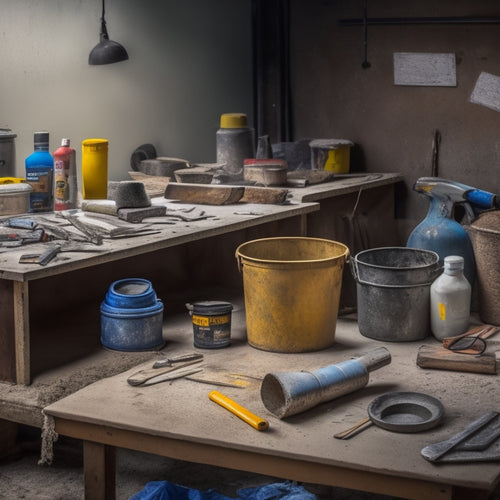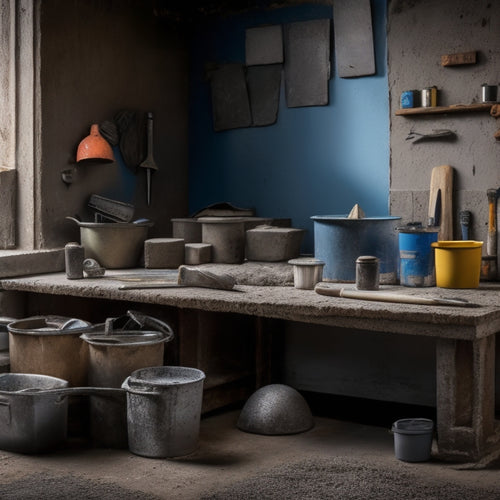
7 Essential Tips for Buying Concrete Sealing Tools
Share
When buying concrete sealing tools, you'll want to define your project needs, evaluating the type of sealing, surface preparation, and application methods. Next, examine the concrete wall condition, considering cracks, moisture, and surface texture. Then, choose the right sealer type based on project requirements and environmental impact. Verify tools are durable, compatible, and versatile, with safety features and ergonomic designs. Don't forget to evaluate reviews and warranties to make an informed investment. By following these essential tips, you'll be well on your way to selecting the right tools for a successful project, and gaining a deeper understanding of what it takes to get the job done effectively.
Key Takeaways
• Assess the concrete wall condition to determine the right sealer type and necessary surface preparation methods.
• Choose a sealer that meets project requirements, considering factors like environmental impact, UV light resistance, and compatibility with chemicals.
• Select tools that are durable, weather-resistant, and compatible with the chosen sealer type and surface preparation methods.
• Evaluate tool ergonomics and safety features, such as slip-resistant handles and non-slip materials, to ensure comfort and safety during use.
• Research reviews and warranty information to ensure an informed investment in quality tools that meet performance expectations.
Define Your Concrete Sealing Needs
Determine the specific type of concrete sealing project you're undertaking, as this will dictate the necessary tools and equipment you'll need to achieve ideal results.
Are you looking to seal a new concrete driveway, or restore an existing one? Are you dealing with cracks, stains, or efflorescence? Knowing the specifics of your project will help you choose the right tools and techniques for the job.
Different sealing techniques require distinct tools and materials. For instance, applying a topical sealant to a newly poured slab demands different equipment than repairing cracks in an aged concrete wall. You'll need to factor in aspects like surface preparation, application methods, and drying times to guarantee a successful seal.
Proper maintenance is also vital to extending the life of your sealed concrete. You'll want to think about investing in tools that'll help you maintain your sealed surface, such as cleaning products and protective coatings.
Assess the Concrete Wall Condition
Your assessment of the concrete wall's condition will reveal its porosity, cracks, and other defects that need attention before sealing, so inspect the surface carefully for signs of damage or deterioration. This essential step will help you identify areas that require repairs or special preparation before applying a sealer.
Here are some key factors to take into account during your assessment:
-
Crack assessment: Look for cracks, fissures, and joints that may allow water to penetrate the concrete. Take note of their width, depth, and length to determine the best course of action.
-
Moisture evaluation: Check for signs of moisture damage, such as efflorescence, staining, or algae growth. This will help you determine the level of sealer penetration required.
-
Surface texture: Note the surface texture, including roughness, smoothness, or porosity, as this will affect the sealer's adhesion and performance.
- Stains and discoloration: Identify any stains or discoloration that may affect the sealer's appearance or performance.
Choose the Right Sealer Type
With your concrete wall's condition assessed, you can now select a sealer that effectively addresses its specific needs, taking into account factors such as desired level of gloss, durability, and breathability.
When choosing a sealer, you'll come across different types, including acrylic, epoxy, polyurethane, and silane. Each type has its unique characteristics, advantages, and limitations. For instance, acrylic sealers are easy to apply and provide a low-gloss finish, while epoxy sealers offer high durability and chemical resistance. Polyurethane sealers, on the other hand, are flexible and suitable for surfaces with high traffic. Silane sealers are ideal for exterior applications due to their water-repellent properties.
It's essential to take into account the environmental impact of your sealer choice. Look for sealers with low VOC (volatile organic compound) content, which reduce the sealer application's environmental footprint.
Additionally, take into account the sealer's compatibility with your concrete wall's specific conditions, such as exposure to UV light, water, or chemicals. By selecting the right sealer type, you'll guarantee a successful sealer application that meets your project's requirements and minimizes its environmental impact.
Consider Tool Material and Quality
When selecting concrete sealing tools, you'll want to take into account the material and quality of the tools themselves.
You need tools that can withstand the demands of the job, and that means evaluating the durability of materials and the weight and ergonomics of each tool.
Durability of Materials
You need concrete sealing tools built to last, as subpar materials can compromise the entire sealing process and lead to costly rework. The durability of materials is essential, as it directly affects the tool's performance and lifespan. When evaluating concrete sealing tools, prioritize materials that can withstand harsh environmental conditions and frequent use.
Here are some key factors to take into account:
-
Material lifespan: Look for tools made from materials with a proven track record of longevity, such as high-quality stainless steel or durable polymers.
-
Weather resistance: Verify the tools can withstand exposure to various weather conditions, including extreme temperatures, humidity, and UV radiation.
-
Corrosion resistance: Select tools with materials that resist corrosion, such as rust-resistant coatings or non-reactive materials.
- Impact resistance: Choose tools that can absorb impacts without compromising their structure or functionality.
Weight and Ergonomics
Selecting concrete sealing tools with ideal weight and ergonomics is essential, as it directly impacts your comfort, productivity, and overall performance during extended sealing operations.
You'll want to look for tools that distribute weight evenly, reducing fatigue and strain on your hands and arms. A well-designed handle is vital, as it should fit comfortably in your hand and provide a secure grip, even with gloved hands.
When evaluating handle design, consider the material and texture. A rubber or foam grip can provide a better hold than a smooth metal or plastic surface. Additionally, look for handles with contoured shapes that fit naturally in your hand, reducing pressure points and discomfort.
Proper weight distribution is also significant. You want a tool that's balanced and doesn't feel too heavy or too light. A tool that's too heavy can cause fatigue, while one that's too light may not provide enough power or control.
Check for Compatibility and Versatility
Before investing in concrete sealing tools, verify they're compatible with your specific sealant type and surface preparation methods. You don't want to end up with tools that can't handle the job or damage your sealant. Conducting compatibility testing and versatility assessment will save you time and money in the long run.
Here are some essential factors to take into account:
-
Sealant type: Make sure the tools are designed for your specific sealant type, whether it's acrylic, polyurethane, or epoxy.
-
Surface preparation: Check if the tools can handle your surface preparation methods, such as grinding, shot blasting, or acid etching.
-
Substrate compatibility: Verify the tools are compatible with your concrete substrate, including its density, texture, and moisture levels.
- Application method: Confirm the tools can handle your application method, whether it's spraying, rolling, or brushing.
Evaluate Safety Features and Ergonomics
When evaluating concrete sealing tools, you'll want to take into account the safety features and ergonomics that guarantee your comfort and protection on the job.
You should look for tools with slip-resistant handle designs that prevent accidents and comfortable grip materials that reduce fatigue.
Slip-Resistant Handle Design
You'll want to opt for concrete sealing tools with handles featuring textured, non-slip coatings or ergonomic grip designs to minimize the risk of accidents and fatigue during extended use. A good handle grip is essential for maintaining control and preventing slips, especially when working with heavy or bulky tools.
Here are some key features to look for in a slip-resistant handle design:
-
Textured coatings: A textured coating can provide a secure grip even in wet or oily conditions.
-
Ergonomic contours: Handles with ergonomic contours fit comfortably in your hand, reducing fatigue and strain.
-
Non-slip materials: Handles made from non-slip materials, such as rubber or foam, can help prevent accidents.
- Contoured finger grips: Contoured finger grips can help you maintain a secure hold on the tool, even when your hands are wet or sweaty.
Comfortable Grip Material
The concrete sealing tool's grip material should provide a comfortable, secure hold, even in demanding work environments, by incorporating safety features and ergonomic design elements that reduce fatigue and prevent accidents.
As you evaluate the tool's grip material, look for a texture that provides a non-slip grip, even with oily or wet hands. A textured grip surface can help prevent accidents caused by dropped tools.
You should also consider the handle design, ensuring it's contoured to fit comfortably in your hand. A well-designed handle will reduce fatigue and discomfort during extended use.
Additionally, a grip material with cushioning properties can help absorb vibrations, further reducing fatigue.
When choosing a concrete sealing tool, don't overlook the importance of a comfortable grip material. It's vital for maintaining control and preventing accidents.
By prioritizing grip material and handle design, you'll be able to work more efficiently and safely, ultimately producing better results.
Read Reviews and Check Warranties
Your research on concrete sealing tools isn't complete without scouring reviews from reputable sources and verifying the warranty terms of each product. This essential step helps you make an informed decision, ensuring you invest in a high-quality tool that meets your needs.
Customer feedback provides valuable insights into the tool's performance, durability, and any potential issues. Pay attention to the overall rating, read both positive and negative reviews, and look for common themes or red flags.
When comparing warranty terms, consider the following:
-
Length of warranty: How long is the warranty period, and what's covered during that time?
-
Coverage extent: What's included in the warranty, and what's excluded?
-
Claims process: How do you file a claim, and what's the typical turnaround time?
- Manufacturer support: What kind of support does the manufacturer offer, and how responsive are they to customer inquiries?
Frequently Asked Questions
Can I Use a Single Tool for Both Indoor and Outdoor Concrete Sealing?
When you're considering concrete sealing, you might wonder if a single tool can handle both indoor and outdoor jobs. Generally, you'll need separate tools for indoor sealing and outdoor sealing due to differences in surface preparation and product application requirements.
How Often Should I Replace My Concrete Sealing Tools?
"Ha! You think your concrete sealing tools will last forever? Think again! You'll know it's time to replace them when you notice worn-out brushes, clogged nozzles, or rusty handles - signs that your tool's durability has reached its limit."
Are Concrete Sealing Tools Suitable for DIY Projects or Just Professionals?
When tackling DIY projects, you'll find concrete sealing tools suitable for your needs, but consider Professional recommendations to guarantee ideal results; assess your DIY considerations, such as skill level and project scope, before investing in tools.
Can I Rent Concrete Sealing Tools Instead of Buying Them?
You can consider rental options for concrete sealing tools, weighing the cost comparison between renting and buying. Calculate the frequency of use and project scope to determine the most cost-effective approach for your needs.
Do Concrete Sealing Tools Come With a Maintenance or Cleaning Kit?
'It's curious you're thinking about maintenance just as you're about to invest in concrete sealing tools! Fortunately, many manufacturers include maintenance kits with cleaning supplies, such as brushes and solvents, to guarantee your tools remain in top condition.'
Conclusion
By following these 7 essential tips, you'll be well-equipped to find the perfect concrete sealing tools for your project.
Remember, the right tools can make all the difference in achieving a professional-looking finish.
Did you know that, according to the American Concrete Institute, concrete sealing can increase the lifespan of a concrete structure by up to 50%?
With the right tools and a little know-how, you can reveal the full potential of your concrete surfaces.
Related Posts
-

3 Best Tools to Buy for Concrete Repair Online
When buying tools for concrete repair online, you'll want to research multiple retailer options to find the best prod...
-

Top Tools for Beginners in Concrete Masonry Coating
You're about to begin a concrete masonry coating project, and having the right tools is essential. Start with essenti...
-

Must-Have Tools for Concrete Planter Projects
As you commence your concrete planter project, you'll need a range of specialized tools to achieve professional-grade...


